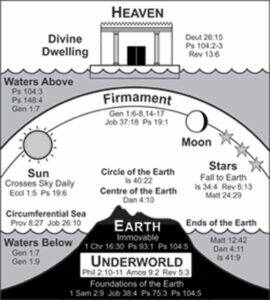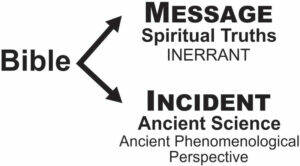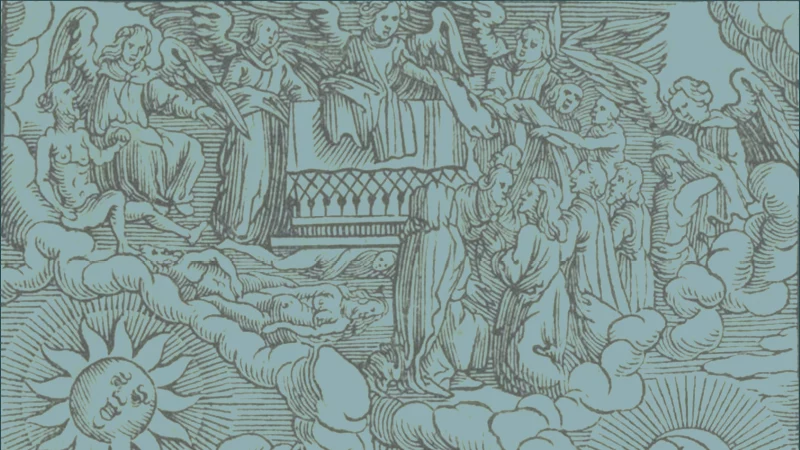During the first day of my college course on the relationship between science and religion, I have my students draw a diagram of the scene that they envision in Genesis 1:2. “Now the earth was formless and empty, darkness was over the surface of the deep, and the Spirit of God was hovering over the waters.” Nearly 90 percent of students sketch a dark, watery, and spherical earth. In reading the word “earth,” they automatically picture a globe. Yet when I ask them if they have ever heard that ancient people believed in a flat earth, they sheepishly say “yes,” and admit that they never made the connection between the Bible and this ancient understanding of the structure of the world.
The interpretive error that most of my students make, and which I made years ago, in picturing Genesis 1:2 as a spherical planet is known as “eisegesis.” The Greek preposition eis means “in, into,” and ēgeomai is the verb “to guide.” Eisegesis refers to an individual reading their ideas or agendas into a passage or book. This is a common error that all of us have made at one time or another in biblical interpretation, and this is the mistake most people make by forcing the modern scientific notion of a spherical earth into the Bible when reading the word “earth.”
The Three-Tier Universe
Let’s turn to another biblical passage to show that Scripture has an ancient understanding of the structure of the world, which we could term an “ancient science.” Philippians 2:6-11 is one of the most important passages in the Bible. It reveals a foundational belief of the Christian faith—God emptied himself and became a man in the person of Jesus in order to die for our sins. The apostle Paul writes in verses 10-11, “[T]hat at the name of Jesus every knee should bow, [1] in heaven and [2] on earth and [3] under the earth, and every tongue confess that Jesus Christ is Lord, to the glory of God the Father.”

Figure 1: The Three-Tier Universe in Scripture
Most Christians rarely notice the reference to an ancient understanding of the structure of the universe in verse 10. This is known as the “three-tier universe” and it is depicted in Figure 1. According to this ancient science, the world had three levels: heaven overhead, the surface of a flat earth in the middle, and a lower region inside the earth. Notably, the English translation “under the earth” is not completely accurate. The actual Greek word that appears in verse 10 is katachthoniōn. It is made up of the preposition kata which means “down,” and the noun chthonios that refers to the “underworld” or “subterranean world.” Therefore, a more precise translation of Philippians 2:10 would be: “that at the name of Jesus every knee should bow, [1] in heaven and [2] on earth and [3] down in the underworld.”
To further illustrate the ancient science in Scripture, consider the creation of the heavens in Genesis 1. On the second day of creation,
God said, “Let there be a firmament in between the waters, and let it divide the waters from the waters.” God made the firmament and divided the waters which were under the firmament from the waters which were above the firmament. It was so. God called the firmament ‘heaven’ (Gen. 1:6-8).
On the fourth day of creation,
God said, “Let there be lights in the firmament of the heaven to separate the day from the night. Let them serve as signs to mark the seasons and days and years; let them be lights in the firmament of the heaven to give light on the earth.” It was so. God made two great lights—the greater light to govern the day and the lesser light to govern the night. He also made the stars. God set them in the firmament of the heaven (Gen. 1:14-17).
The original biblical word translated as “firmament” in these passages is the Hebrew noun rāqîa‘. It is related to the verb rāqa‘ that has the meaning “to flatten,” “hammer down,” and “spread out.” In particular, this verb has the sense of flattening something solid, and it is found in the context of pounding metals into thin plates. For example, Exodus 39:3 states, “They hammered out thin sheets of gold.” The related noun riqqûa‘ refers to metal sheets. As Numbers 16:38 commands, “Hammer the [metal] censers into sheets to overlay the altar.”If we consider these passages in Genesis 1 that deal with the creation of the heavens in light of the ancient three-tier universe, they make perfect sense. The verb rāqa‘ is even found in a passage that refers to the creation of the sky, which is understood to be solid and similar to a metal. Job 37:18 asks, “Can you join him [God] in spreading out [rāqa‘] the skies, hard as a mirror of cast bronze?”
If we consider these passages in Genesis 1 that deal with the creation of the heavens in light of the ancient three-tier universe, they make perfect sense. For example, when ancient people like the Holy Spirit-inspired biblical writers looked up at the sky, they saw a massive blue dome. To believe that there was a heavenly body of water held up by a solid domed structure like an inverted bowl was quite reasonable. As Figure 1 shows, this water is termed the heavenly “waters above.” In addition, if we view the sun, moon, and stars from the point of view of only the naked eye, they are right up against the blue dome, giving the appearance that they are embedded in its surface. In other words, from an ancient phenomenological perspective this was the best science-of-the-day in ancient times. Therefore, we need to read the Word of God through ancient eyes and with an ancient mindset.
Now it is very important to distinguish between ancient and modern phenomenological perspectives, and not to confuse them or conflate them together. This is another common error made today by Christians reading Scripture. Observation in the ancient world was limited to unaided physical senses and what ancient people saw with their naked eyes, they believed to be real, like the literal rising and setting of the sun (e.g., Eccl. 1:5; Ps. 19:4-6; Matt. 5:45). In contrast, we have the advantage of scientific instruments like telescopes. When we see the sun “rising” and “setting,” we know that this is only an appearance or visual effect caused by the rotation of the earth.
Now I suspect there are some of you who are probably asking the question, “Did God lie in the Bible?” My answer to this question is an absolute “NO!!!” In fact, Scripture states quite clearly in Titus 1:2 that God “does not lie,” and Hebrews 6:18 asserts that “it is impossible for God to lie.” Lying requires an individual to be deceptive, and the God of the Bible is certainly not a God of deception.
The God of Christianity is a God of truth and love. In order to reveal himself to an ancient people like the Hebrews and early Christians, he graciously came down to their intellectual level to communicate his life-changing spiritual truths. In other words, the Lord accommodated. For example, in Philippians 2:9-10, the Holy Spirit allowed the apostle Paul to use the ancient notion of the three-tier universe as an incidental vessel to deliver an inerrant message of faith. As a result, Paul and his readers would have fully comprehended that Jesus is the Lord of the whole world, because from their ancient phenomenological perspective, the three-tier universe was understood to be the entire universe.
Six Reasons to Accept Accommodation
It must be acknowledged that some Christians complain that the principle of biblical accommodation “weakens” or “waters down” the Scriptures. I certainly appreciate their concern. But here are six reasons that I find persuasive for accepting the belief that accommodation is a feature of the Word of God.
First, divine revelation by necessity requires God to accommodate. Stated another way, for an infinite Creator to communicate with finite creatures, he must come down to our level—otherwise we would never understand. The mind of God is so much greater than the mind of humans. As the Lord states in Isaiah 55:8-9, “For my thoughts are not your thoughts . . . As the heavens are higher than the earth . . . so are my thoughts higher than your thoughts.”
Second, the greatest act of divine revelation is the Incarnation. The Latin noun carnis means “flesh.” John 1:14 states Jesus “became flesh and made his dwelling among us.” Similarly, Philippians 2:7-8 asserts that the Lord “humbled himself”For an infinite Creator to communicate with finite creatures, he must come down to our level—otherwise we would never understand. and “made himself nothing” in order to become a man. In other words, God accommodated by taking on human flesh, and through this ultimate act of accommodation, the Lord revealed his unfathomable love for us by dying on the Cross for our sins.
Third, Jesus often employed parables in his teaching. Simply defined, parables are earthly stories with heavenly messages. The Lord included “earthly” ancient scientific notions-of-the-day, like the mustard seed being the smallest of all seeds (Mk. 4:30-32), in order to deliver inerrant spiritual truths about the kingdom of God.
Fourth, the Lord was fully aware of the limitations of humans. Following his parable of the mustard seed, Mark 4:33 comments, “With many similar parables Jesus spoke the word to them, as much as they could understand” (emphasis added). Clearly, the Lord accommodated to the intellectual level of his disciples and audience in order to teach as skilfully as possible his messages of faith.
Fifth, Christians experience accommodation in their prayer life. Most would agree that God meets us exactly where we are at in our life, and that he talks to us at our level of comprehension. And as we grow spiritually over time, the Lord reveals himself using spiritual beliefs that are more mature. God knows us better than we know ourselves, and also knows the best way to communicate his inerrant truths so that we can fully grasp them.
Finally, everyone at some point uses accommodation, because it is an effective and natural way to communicate. For example, when a four-year-old asks where babies come from, parents answer by coming down both physically to their knees and intellectually to the level of understanding of the child. They communicate the message of faith that a baby is a gift from God without presenting the incidental details of sexual reproduction. In other words, it is possible to reveal inerrant spiritual truths without using actual scientific facts.
The Message-Incident Principle

Figure 2: The Message-Incident Principle
Let me introduce an interpretive principle for biblical passages that refer to the physical world—the Message-Incident Principle in Figure 2. I am convinced that most Christians already accept this concept in some implicit way. First and foremost, we all believe that the main purpose of the Bible is to reveal inerrant spiritual truths. The word “inerrant” means “to be absolutely true and completely free from error.” Scripture also has an incidental ancient science that was based on an ancient phenomenological perspective of the natural world. The word “incidental” has the meaning of “that which happens to be alongside” and “happening in connection with something more important.” In this way, the ancient science in Scripture is found “alongside” the “more important” inerrant spiritual truths revealed by the Holy Spirit to the biblical writers.
It is important to add that the ancient science in the Bible plays a critical role in delivering these messages of faith. The ancient scientific ideas are similar to a cup that holds water. Does it really matter whether a cup is made of glass, plastic, or metal? No. The material that it is made of is incidental. What matters is that a vessel is needed to bring water to a thirsty person. Similarly, the incidental ancient science in Scripture is like a cup that delivers “living water” (Jn. 4:10) to our thirsty souls.
To conclude, let’s answer the question posed in the title of this essay: does the Bible teach a wrong cosmology, and does the doctrine of accommodation shed light on this question? The word “teach” is the key word. I do not believe that the purpose of Scripture is to teach or reveal science, let alone ancient science. Instead, the Bible employs an ancient cosmology as an incidental vessel to deliver life-changing spiritual truths. And similar to the incarnation, the Lord graciously accommodated and came down to the level of ancient humans in Scripture to reveal that he alone was the Creator and Sustainer of this “very good” (Gen. 1:31) creation that “declares his glory” (Ps. 19:1).







Comments
Be the first one to make a comment!